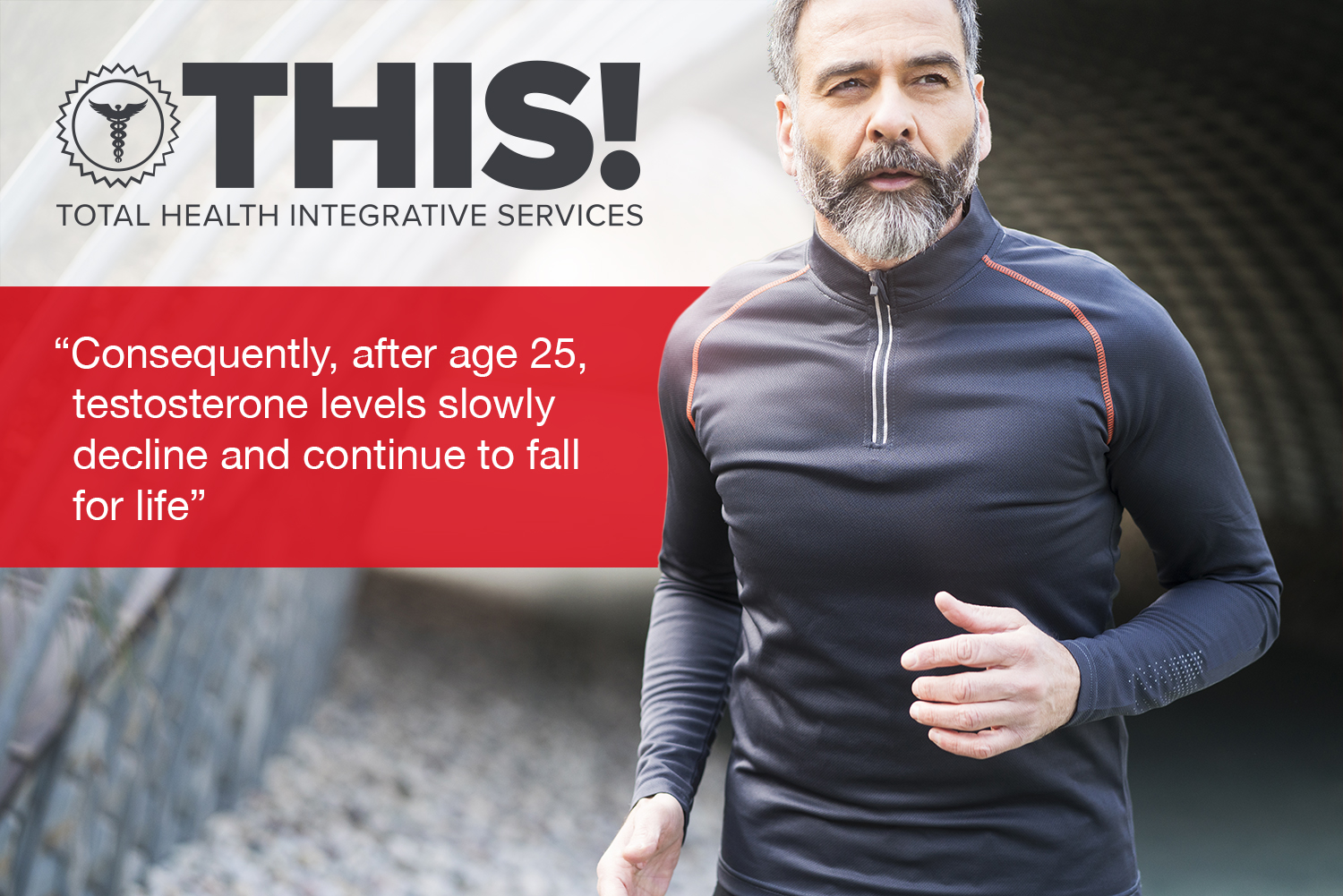Summary:
- Testosterone is essential to healthy libido, muscle mass, mood, energy, stamina, and more
- Testosterone peaks at ages 18-25
- Testosterone starts to decline, for a number or reasons, at ages 25-30
- The body of an older man needs as much testosterone as it did when he was younger
- Most men aged 30-40 begin to suffer from testosterone deficiency severely enough to justify testosterone supplementation, at least at a low dose
What is testosterone?
Testosterone, also called the “male hormone,” is a natural substance which is produced daily by the body and is truly the key to masculinity. Testosterone plays a vital role with sex drive, sexual performance, bone density, muscle mass, red blood cell production, and even the way men store body fat.
What are common signs of low testosterone?
- Cloudy mind
- Decreased libido
- Poor mood
- Decreased muscle mass
- Undesirable sexual performance
- Less youthful skin tone
- Increased fat, especially abdominal
- Lower bone strength
- Decreased energy & stamina
- Poor sleep quality
Where is testosterone produced?
Testosterone is mainly produced by the testicles in Leydig cells. Leydig cells are interstitial cells and the best-established function for them is to produce testosterone under the pulsatile control of pituitary luteinizing hormone (LH). There are about 7,000,000 Leydig cells in the testicles of young men. Small amounts of testosterone are also produced in the two adrenal glands, one located above each kidney.
How much testosterone does a man produce daily?
A 150-pound young man produces roughly 7 milligrams of testosterone per day. For contrast, this is about 20-times higher than a woman. Of those 7 milligrams, 6.7 milligrams are produced by the testicles and the remaining 0.3 milligrams are produced by the adrenal glands above the kidneys.
To better understand the scale, 7 milligrams are 10 million times lighter than the 150 pounds used in the example bodyweight above. However, despite this small amount, testosterone drives the appearance of the male body in a powerful way, giving it the features typically considered masculine. It also makes the male mind sharp and focused. To go further, 7 milligrams of testosterone are equivalent to approximately 15-billion testosterone molecules, and an average size person has about 100,000 billion cells. This results in an average of 1.5 million molecules of testosterone penetrating each and every cell in the human body every day!
What are the main triggers of testosterone production?
Production of testosterone is greatly stimulated by the pituitary luteinizing hormone (LH), and accessorily by folic-stimulation hormone (FSH). Testosterone levels are very low in individuals who do not produce LH (less than 30% of normal).
Do testosterone levels fluctuate?
Yes, testosterone levels fluctuate. In young men, a circadian rhythm of serum testosterone has been documented with 20% higher levels of testosterone in the morning than those measured in the evening. This circadian rhythm disappears in older men.

How does testosterone decline due to aging?
Peak testosterone levels are found at ages 18-25. Testosterone production starts to decline at ages 25-30, and even sooner in some men. Consequently, after age 25, testosterone levels slowly decline and continue to fall for life.
This is especially true inside the cells (intracellular), where testosterone levels decline with age. The levels of free testosterone, the testosterone that is not bound to proteins and easily penetrates the cells, decreases by more than 50% in older men compared to younger men.

This decline deprives men of testosterone their bodies need to function well. In fact, older men need as much testosterone as they did in their youth. Their older bodies are of a similar size as their younger ones, and they still require the same amount of testosterone to maintain proper function. With aging, older men no longer produce the amount of testosterone needed for a youthful appearance, strong muscles, and the sharpest mind. Overtime, they gradually start to develop testosterone deficiency and experience the resulting decline in health.
Why do testosterone levels decline in men?
First, a decrease in testosterone producing Leydig cells occurs in older men. For reference, a young man has an average of 7,000,000 Leydig cells and an 80-year-old only has about 2,000,000 Leydig cells. This decline corresponds to an average net loss of 1 testosterone producing Leydig cell every 4-5 minutes. It’s true that new Leydig cells are formed daily, but over time, after age 25, Leydig cells disappear faster than new ones appear.
Second, Leydig cells decline in quality as well as quantity. Each remaining Leydig cell functions with reduced efficiency and experiences increasingly greater challenges producing testosterone. Therefore, the Leydig cells that remain in a 40, 60, or 80-year-old man are weaker and not able to produce as much testosterone as an equal number of young Leydig cells can.
Third, an aging-related progressive increase in the serum level of sex hormone binding globulin (SHGB) compounds the problem by causing intracellular testosterone deficiency. SHGB is the large protein responsible for transporting testosterone, which is tightly bound to it, in the blood. When a man has high SHGB levels, more testosterone is bound to SHGB and less is free to enter the target cells.
Fourth, the target cells themselves become less sensitive to testosterone as they age. This decline in target cell efficiency is due to several factors, including:
- a decrease in the number and quality of its intracellular testosterone receptors,
- the accumulation of waste products inside the target cells that hinder metabolic activities, and
- a decrease in functional enzymes to express the effects of testosterone.

Fifth, as a result of previous actions, the metabolic effects of testosterone on the male body also decline with age. In laboratory tests, the reduction in testosterone action is reflected by a decrease in testosterone metabolites. Each time a testosterone molecule reaches and binds to a testosterone receptor in the nucleus of a target cell and starts the metabolic chain reactions leading to a beneficial effect, it slightly changes structure and becomes a less active metabolite, such as androsterone and etiocholanolone. Androsterone and etiocholanolone can be measured in 24-hour urine, while the best androgen metabolites in the serum to assess are the (very active) dihydrotestosterone and (the much less active) androstanediol glucuronide. In fact, androstanediol glucuronide is so abundant in the blood of young healthy men that it is approximately double that of testosterone. Studies show that the decline in testosterone metabolites is greater than the decrease in the free and total testosterone levels in the serum.
The gradual drop in serum, urinary, and tissue levels of testosterone and its metabolites, along with the consequent drop in the beneficial psychological and somatic effects of testosterone, suggest that most middle-aged men begin to suffer from the symptoms and signs of testosterone deficiency severely enough to justify testosterone supplementation, at least at a low dose.
Bioidentical Hormone Replacement Therapy is simple and affordable
Start NowScientific References
1. Kraemer WJ, Loebel CC, Volek SJ, Ratamess NA, Newton RU, Wickham RB, Gotshalk LA, Duncan ND, Mazzetti SA, Gomez AL, Rubin MR, Nidle BC, Hakkinen K. The effect of heavy resistance exercise on the circadian rhythm of salivary testosterone in men. Eur J Appl Physiol. 2001 Jan-Feb; 84(1-2):13-8.
2. Cao J, Aou H, Zhu BP, Wang H, Li J, Ding Y, Li XY. Sex hormones and androgen receptor: risk factors or coronary heart disease in elderly men. Chin Med Sci J. 2010 Mar;25(1):44-9. (Age was negatively correlated with TT (r = -0.28, P = 0.00) and FT (r = -0.17, P = 0.01))
3. Lam KS. Serum total and bioavailable testosterone levels, centra obesity, and muscle strength changes with aging in healthy Chinese men. J Am Geriatr Soc. 2008 Jul;56(7):1286-91 (“The rates of decline in serum total testosterone and bioavailable testosterone levels were 0.2% and 1.14% per year”)
4. Andersson AM, Jensen TK, Juul A, Petersen JH, Jorgensen T, Skakkenbaek NE. Secular Decline in Male Testosterone and Sex Hormone Binding Globulin Serum Levels in Danish Population Surveys. J Clin Endocrinol Metab. 2007 Dec;92(12):4696-4705
5. Travison TG, Araujo AB, Kupelian V, O’Donnell AB, McKinlay JB. The relative contributions of aging, health, and lifestyle factors to serum testosterone decline in men. J Clin Endocrinol Metab. 2007 Feb;92(2):549-55
6. JE Morley 1, F Kaiser, WJ Raum, HM Perry 3rd, JF Flood, J Jensen, AJ Silver, E Roberts. Potentially predictive and manipulable blood serum correlates of aging in the healthy human male: progressive decreases in bioavailable testosterone, dehydroepiandrosterone sulfate, and the ratio of insulin-like growth factor 1 to growth hormone. Proc Natl Acad Sci USA. 1997 Jul 8;94(14):7537-42
- Can Anything Be Done to Stop Menopausal Symptoms? - May 27, 2022
- Jonathan’s Story - August 24, 2021
- Heavy Metal Toxicity is More Common Than You May Think - August 17, 2021
